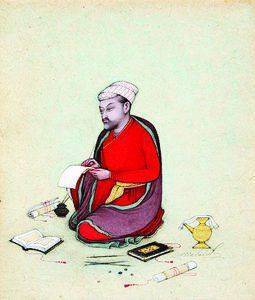Mahaveer Swami’s sensitive strokes have been infusing life into the dying art of miniature painting in Bikaner
Clad in a thin cotton shirt and dhoti, Mahaveer Swami sits on his old diwan and desk, meticulously making his drawings. The five elements are going to come alive in this miniature. For months, he has been working on this project called the Mahayagya, but it doesn’t bother this 60-year-old national award winning artist. Time seems to come to a standstill in the 300-year-old room which is his studio.
The walls are lined with his works. He points out at a small alcove where the footprints of a saint lie. “This room was once the temple of a saint. My priestly ancestors were the guardians and this was gifted to them. Then they built the house around it,” says Swami.
Older than the room is his art — the 500-year-old miniature style of painting, which got an impetus under the founder of Bikaner, Rao Bika. “Miniature art goes back to the 6-7th century AD. It flourished in the Mughal era in the 16th century,” says Swami who belongs to the Bikaner laghu chitra gharana aka miniature arts gharana.
For more than four decades, Swami has been infusing life into the traditional Bikaner style. Light strokes, sensitive expressions, translucent and subtle colouring, the USP lies in fine detailing of the figures in natural colours.
With a shy smile, he reveals two prestigious awards given by the President of India — ‘Master Craftsman’ award in 1986 and the Sanskriti award in 1992.
Mythology and history are the major components of the style. Most paintings have scenes related to the courts of Ram and Vishnu, kalpavriksha and nature. And then there are the clouds, home to the gods who watch over Earth. This motif can be seen in many heritage structures in Bikaner — Junagarh Fort, Maharaja Ganga’s Singh residence Laxmi Niwas palace, as well as the old havelis. In fact, the clouds are so much a part of the art that Swami has meticulously used them in his yoga series. But they are only visible with a microscope. From this series, the surya namaskar was exhibited in Australia. Another new motif is the ibex in his works.
He has painted on silk too, besides handmade paper. A lot of his artworks have been featured in the book Art of Bikaner.
Inspired by the traditions of the Far East and the Sufis, Swami has done a scroll of botanicals in a collaborative project. In fact, he will be attending the annual conference on botanicals at St Louis this year.
But this isn’t the first time that he is travelling abroad. “My work is displayed in Museum of Sacred Art (MOSA), Belgium, where I held a solo show.” He has exhibited in over 100 shows and travelled to many countries, including the USA, France, Korea, Japan, Australia. “I have learned a lot from other artists and attended many residency programmes,” he says.
Opening his cupboard, he elucidates that he collects natural colours from all over. “The colours are made from vegetables, minerals, stones. Earlier, they were made from precious stones, conch shells, pure gold and silver, indigo, but now these are expensive and difficult to source,” he adds. He uses gold to highlight the jewellery and other accessories. Blackened metal colour is the focus in many of his paintings.
There is a new project on the anvil — related to scenes of the Govardhan where Krishna and Balram are with a herd of cows in the evening. But nothing came on a platter, “My father, MR Swami, worked in a railway workshop as a painter. My grandfather, MD Swami, was a stone mason who painted frescoes and murals on the havelis”, he says.
Unable to give a timeline to when he wanted to pursue art, Swami says he practiced it on every material available — jute bags, paper, cloth and more.
However, it was a tedious journey. Even after getting a diploma in Painting & Sculpture from the Rajasthan School of Art in Jaipur (1980- 1985), he only got to work on copies. Seeing his passion, his mentor in college urged him to work on the Bikaner miniature style and that changed everything. He worked on all kinds of materials, including ivory, to hone his art.
Striving to keep the ages old art alive, Swami has trained his 33-year-old son Anurag now. Currently, they are painting a project related to hatha yoga postures and the mahayagya.
But Anurag is not his only student. He teaches groups who come through government programmes and also on their own. He just trained a group from Spain. The process of keeping the labour-intensive art alive is timeless and the father-son duo hopes to bring out a set of colouring books for all. Till then, work continues in the temple studio.





